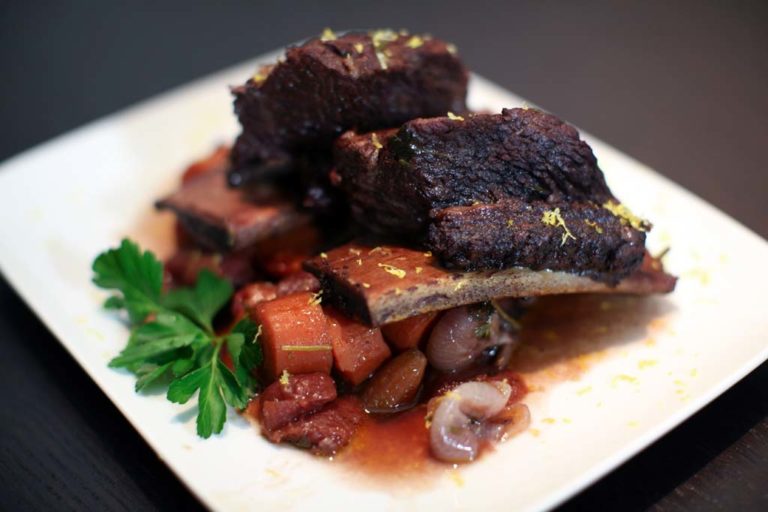
Chef's notes:
Short ribs have become very popular in the past few years. But what exactly are they? An English-style short rib is a short piece of rib, 5‒6 inches long, with a square piece of often fatty meat attached. There isn’t a set place on the ribs that these are cut from, and some pieces will be fattier than others. But they should be roughly the same shape and size. There is another type of short rib called flanken-style short ribs. These are cut across the grain and include several shorter pieces of rib, like a cross section. These flanken-style ribs are more money and harder to find. So this article was completed with English-style short ribs.
Short ribs can be roasted, grilled, or pan fried, but almost every recipe will include some time in a braising liquid. The connective tissue is hard to break down otherwise. Some recipes may call for boneless ribs. Boneless ribs will not render as much fat as bone-in, but the tradeoff there is the marrow and thickening gelatin that comes from the bone.
Ingredients
- 3 pounds beef short ribs
- 16 cipollini onions, whole peeled
- 2 carrots, peeled roll cut
- 1 14‒16 oz can peeled whole tomatoes
- 2 cups cabernet sauvignon
- 1 cup light or dark chicken stock
- 5‒7 cloves garlic, minced
- 2 sprigs rosemary
- 4 sprigs thyme
- 2 sprigs oregano
- Salt
- Black pepper
- 4 Tbsp butter
- Balsamic vinegar
- Lemon zest
- Parsley
Braised Beef Short Ribs Recipe: Red Wine and Chicken Stock with Herbs, Cipollini Onions, Garlic, and Tomato
- Get together the ingredients for the braised short ribs. The recipe that I came up with for this article is a version of a fairly classic braising liquid that I use frequently. It essentially consists of red wine, stock, tomato, onion, salt, pepper, and herbs. You may add and remove as you like. For example, you could use tomato paste instead of whole tomatoes or chicken instead of beef stock. I love cipollini onions even though they are a little extra work. For tips on trimming the fat off the ribs, look at the bottom of the page.
- Heat up the braising pan over medium-high heat. For this article I chose to use butter as the frying medium. Another good choice would have been olive oil, but I prefer butter for this recipe. Melt it in the pan and stir it around until the foam subsides and it starts to get brown. Then lay the ribs in the pan. It will take about a minute per side to get the whole rib browned. Before you brown the short ribs, make sure to trim the fat like in the picture at the bottom of the page. Other than that, just salt and pepper them.
- Set the browned short ribs to the side on a plate. Preheat the oven to 350ºF. Turn the heat down on the braising pan to medium and toss in the carrots, onions, and garlic. Use a wooden spoon and stir the veggies for 4 minutes until they begin to brown and soften. Some of the drippings will come up as you cook. Don’t worry about this. The “fond,” as it is known, will add flavor and richness to the sauce. The onions are left whole, the carrots should be about the same size, and the garlic should be chopped finely.
- Add the wine to the braising pan. As you add the remeasured 2 cups of wine, scrape at the bottom of the pan with the wooden spoon. This will help to get the drippings off the bottom and into the sauce. It will also make cleaning the pan easier. Add the chicken stock and tomatoes too. Then add the browned short ribs back to the pot. Finally, add the herbs. Turn the heat off and put the lid on. Put the braising pan into the preheated oven and set the timer for 1 hour.
- After an hour, take the braising pan out of the oven. Flip the short ribs over and put the braising pan back in the oven for another hour. After that hour has passed, flip them again. This time only set the timer for 30 minutes. Once that time has passed, remove the pan and check the ribs. The meat should be fork tender. If not, flip them again for another 30 minutes. When the ribs are done, serve them with a drizzling of balsamic vinegar and some fresh lemon zest as well as the braising liquid for a sauce.
Tips & Tricks
- For best results, remove as much fat from the short rib as possible. For some short ribs this may be a lot and for others not so much. Another option is to remove the bone. There is a not-very-yummy piece of connective tissue between the meat and the bone. This is the most unappetizing part. The bone will be easy to remove; just cut the meat off it. But make sure to also remove this connective tissue. In the picture you will notice I am mostly concerned with removing the thick fat on top. Also be sure to remove any tallowy fat. Tallowy fat is the hard crumbly stuff and is not good to eat.
